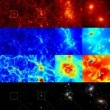What is dark matter?


I/LIGHT DARK MATTER CANDIDATE
Rasera, Y., Teyssier, R., Sizun, P., Casse, M., Fayet, P., Cordier, B., Paul, J.,
Soft gamma-ray background and light dark matter annihilation, 2006, Phys. Rev. D, 73, 103518
Dark matter indirect detection and 511 keV gamma-ray line
Dark matter is sensitive to gravity, and it is probably not sensitive to electromagnetic force otherwise we would have already detected it. However, in the standard cosmological model, dark matter is sensitive to another type of interaction (weak force or other), with a cross-section which is constrained so as to get the correct relic abundance (after the big bang). As a consequence, dark matter particles should annihilate and produce other particles, that may be easier to detect. The light dark matter candidate we have studied here was introduced by Pierre Fayet. It has a mass typically between 1 MeV and GeV and annihilate into electron-positron pairs. Produced positrons annihilate with surrounding electrons and produce a 511 keV gamma-ray line. At the same time, INTEGRAL satellite has detected a strong 511 keV gamma-ray line from galactic center of unknown origin. The center of the galaxy is also the place where dark matter density is the strongest. Does the 511 keV line from the galactic center come from light dark matter annihilation? In this case every dark matter halo in the universe should emit a strong redshifted 511 keV line and contribute to the soft gamma-ray background. Is the corresponding background compatible with the observed one or do we face another Olbers-like problem that would rule out this dark matter candidate?
Soft gamma-ray background from dark matter annihilation: the role of baryons
The soft gamma-ray background between 100 keV and 511 keV has been observed observed by HEAO and COMPTEL. In this range, we expect contribution from SNIa, Seyfert and blazars. The remaining unexplained contribution is of order 4 keV/cm2/s/sr, this is an upper limit for the possible background from dark matter annihilation. Assuming mass functions and dark matter profiles given by an analytical model adjusted on cosmological simulations, we have sumed the redshifted 511 keV emission from dark matter annihilation for all halos at all redshifts. As previous studies, we obtained a rather high soft gamma-ray background dangerously close from the upper limit (if one wants to explain the galactic signal at the same time). However, we took into account the crucial role of baryons in confining and annihilating dark matter positrons. As explained in the section about dark baryons, only large enough halos have a dense interstellar medium and associated magnetic field required to trap and annihilate positrons. We have therefore restricted the contribution to large enough halos.
Dark matter constraints
As a result, dark matter annihilation soft gamma-ray background has decreased by a factor of ten and there is more room for this light dark matter candidate. The constraints on its mass and cross section for this candidate are summarized in the above plot. Typically, if one wants to explain both the 511 keV line from the galactic center and still be compatible with soft gamma-ray background, radio/gamma emission from the galactic center, and thermal relic, the mass and (velocity-independant part of) cross-section have to stay in the shaded regions.
What is dark matter?





Fields of research

Various constraints on the mass and cross-section of a candidate light dark matter particles which anihilate into electron-positron pairs. The upper line come from relic density constaints. Left line from elecron mass, right line from galactic center radio/gamma signal, left corner from the soft gamma ray background. Finally the dashed region is compatible with the 511 keV emission from the galactic center as measured by INTEGRAL.
Credits: Rasera et al, 2006